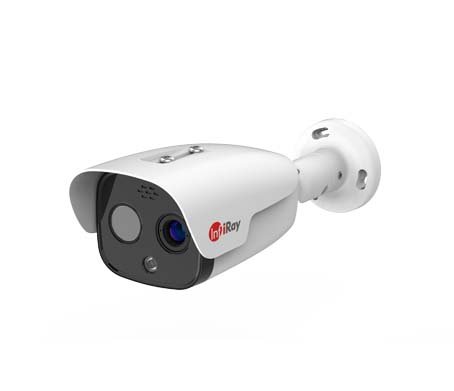In the realm of security and surveillance, thermal security cameras have emerged as a pivotal technology. These cameras, leveraging the power of infrared thermal imaging, have revolutionized how we monitor, protect, and manage various environments. This article delves into the intricacies of thermal security cameras, exploring their technology, applications, and the value they bring to a wide array of sectors.
The Core Technology of Thermal Security Cameras
At the heart of every thermal security camera lies an infrared detector. This component is responsible for capturing infrared radiation emitted by objects, regardless of the lighting conditions. Unlike standard cameras that rely on visible light, thermal cameras visualize heat, offering a distinct advantage in darkness or obscured conditions.
The infrared spectrum is divided into three main categories: near-infrared (NIR), mid-infrared (MIR), and far-infrared (FIR). Thermal security cameras primarily operate in the FIR range, specifically in the 8-14 micron wavelength band, which corresponds to the thermal radiation emitted by objects at normal temperatures.
When an object or a person absorbs or emits heat, the thermal energy is converted into infrared radiation. Thermal cameras detect this radiation and translate it into an image, where different temperatures are represented by varying shades of gray or color. This allows users to distinguish between warm and cool objects, making it possible to detect the presence of individuals, identify potential threats, and monitor various activities in a given area.
One notable product in this category is the Night Vision Infrared Camera from InfiRay, which exemplifies high performance in total darkness. This technology is not only pivotal for security but also for animal observation, ensuring the safety and monitoring of wildlife without disturbing their natural habitats.
Applications of Thermal Security Cameras
Thermal security cameras find their applications in a myriad of fields. Here are a few notable ones:
- Security and Surveillance: They provide round-the-clock monitoring capabilities, detecting intruders based on their heat signatures. Thermal cameras can be used to secure perimeters, monitor restricted areas, and enhance overall situational awareness.
- Wildlife Observation: These cameras play a crucial role in animal protection, allowing researchers to observe nocturnal wildlife without causing disturbance. They are particularly useful in monitoring the movements, behaviors, and population dynamics of various species.
- Industrial Monitoring: Thermal cameras can detect overheating equipment or leakages, preventing accidents before they occur. They are invaluable in predictive maintenance programs, helping to identify issues before they become major problems and reducing downtime and costly repairs.
- Healthcare: In medical diagnostics, thermal imaging can reveal heat patterns that indicate various health conditions, such as inflammation, circulation issues, and even early signs of certain diseases.
Advantages of Using Thermal Security Cameras
Why opt for thermal security cameras? The reasons are manifold:
- They operate effectively in complete darkness, providing reliable surveillance regardless of lighting conditions. This makes them particularly useful in remote or hard-to-reach areas where traditional visual cameras may be less effective.
- Thermal cameras can see through obstructions like smoke, fog, and dust, offering clarity where traditional cameras fail. This capability enhances the overall situational awareness and decision-making process for security personnel.
- They enable the monitoring of wildlife without any light pollution, contributing to animal protection efforts by observing nocturnal species in their natural habitats without causing disturbance.
Choosing the Right Thermal Security Camera
When selecting a thermal security camera, consider the following factors:
“Evaluate the camera’s resolution and sensitivity, as these will determine its ability to capture detailed images and detect subtle temperature differences.”
Furthermore, assess the camera’s range and field of view to ensure it meets your surveillance needs. For instance, the Tianji G600 Uncooled Infrared Camera for Gas Detection from InfiRay, with its high-definition and custom band-pass features, is an excellent choice for industrial monitoring.
Another important consideration is the integration capabilities of the thermal security camera with existing security systems. The ability to seamlessly integrate with video management software, access control systems, and other security infrastructure can enhance the overall effectiveness of the surveillance setup and facilitate a more comprehensive approach to security.
Case Study: InfiRay’s Thermal Security Camera Solutions
InfiRay, a leading provider of thermal imaging technology, offers a comprehensive range of thermal security cameras designed to meet the diverse needs of various industries. Let’s take a closer look at two of their innovative solutions:
InfiRay Tianji G600 Uncooled Infrared Camera for Gas Detection
The Tianji G600 is a high-performance thermal camera specifically designed for industrial monitoring and gas detection. With its advanced uncooled microbolometer technology, the G600 can detect temperature differences as small as 0.05°C, making it highly sensitive to even subtle changes in heat signatures.
Key features of the Tianji G600 include:
- High-definition image quality with a resolution of 640 x 512 pixels
- Customizable band-pass filters for targeted gas detection
- Accurate temperature measurement and hot spot identification
- Seamless integration with existing security and monitoring systems
InfiRay Eye II Series V3.0 Mini Thermal Monocular
For security and wildlife observation applications, the Eye II Series V3.0 Mini Thermal Monocular from InfiRay offers a compact and versatile solution. This handheld device leverages thermal imaging technology to provide clear visibility in total darkness, making it an invaluable tool for a wide range of surveillance and monitoring tasks.
Key features of the Eye II Series V3.0 Mini Thermal Monocular include:
- Lightweight and portable design for easy field use
- High-resolution thermal imaging with a 384 x 288 pixel sensor
- Adjustable display brightness and contrast for optimal visibility
- Long battery life and rechargeable via USB-C
Read also Connect Security Cameras To TV: Easiest Way To Go
Conclusion
Thermal security cameras stand at the forefront of surveillance technology, offering unparalleled capabilities in monitoring, safety, and wildlife protection. As we have seen, their applications span across various sectors, making them an invaluable tool in today’s technologically driven world. For those interested in exploring more about these innovative solutions, InfiRay offers a comprehensive range of products designed to meet diverse needs.
Whether for security, industrial monitoring, or animal observation, thermal security cameras provide a reliable, efficient, and non-intrusive means of capturing critical information, day or night. By understanding the core technology and carefully selecting the right camera for your specific requirements, you can unlock the full potential of this transformative surveillance technology.






What a fantastic piece! Your clear explanations and attention to detail make this article stand out.
It’s obvious you’re an expert in the field, and I appreciate how you’ve made it accessible to all readers.
Information Technology (IT) refers to the use of computers, networks, storage, and other physical devices,
as well as the systems, infrastructure, and software, to create, process, store, and exchange electronic data.
information technology
You can use WhatsApp without saving number to send messages instantly. Just enter the phone number correctly and start chatting. It’s a fast and hassle-free way to connect.